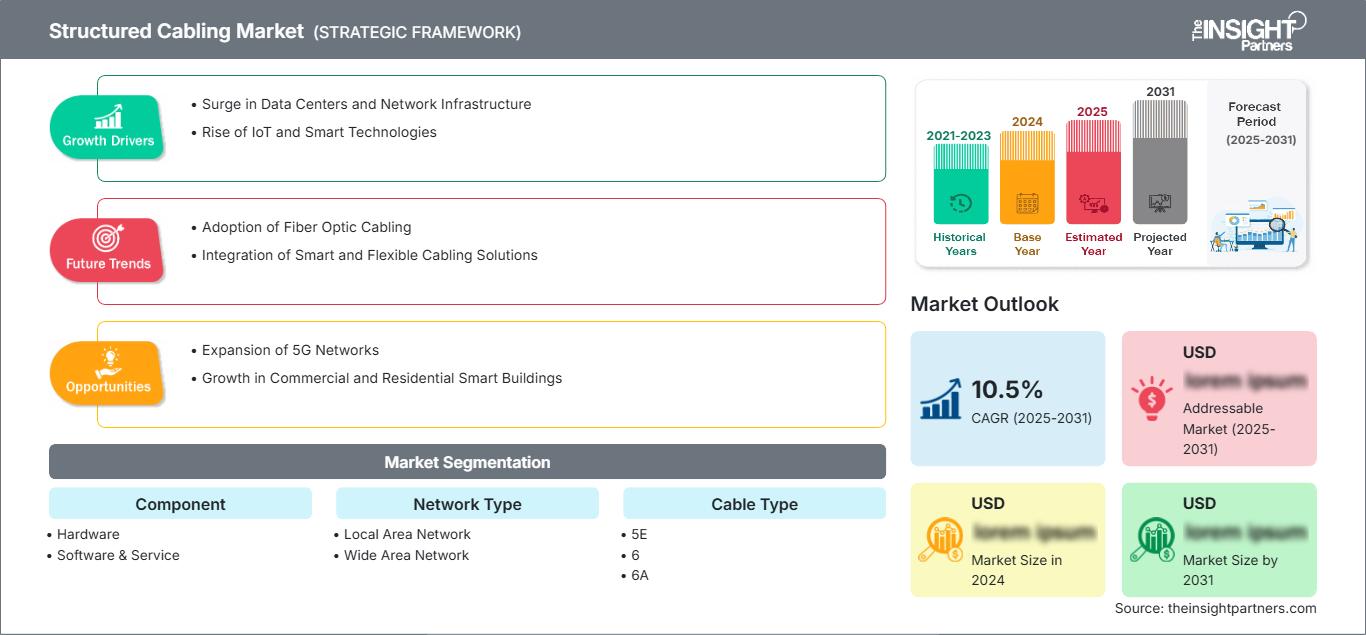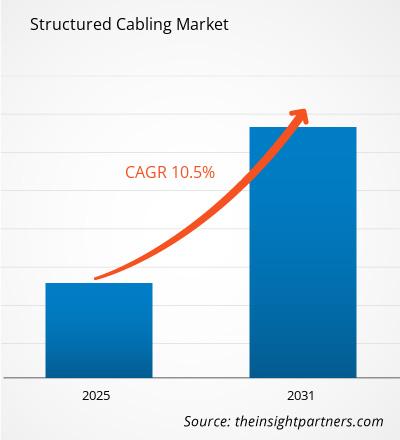Se prevé que el mercado de cableado estructurado registre una tasa de crecimiento anual compuesta (CAGR) del 10,5% entre 2025 y 2031, con un tamaño de mercado que se expandirá de XX millones de dólares estadounidenses en 2024 a XX millones de dólares estadounidenses en 2031.
El informe se segmenta por componente (hardware, software y servicios), tipo de red (red de área local y red de área extensa), tipo de cable (5E, 6, 6A y otros) y uso final (gobierno y defensa, sanidad, TI y telecomunicaciones, industria manufacturera, edificios residenciales y comerciales, transporte y otros). El análisis global se desglosa a su vez por regiones y países principales. El informe presenta el valor en USD para los análisis y segmentos mencionados.
Finalidad del informe
El informe sobre el mercado del cableado estructurado, elaborado por The Insight Partners, tiene como objetivo describir el panorama actual y el crecimiento futuro, los principales factores impulsores, los desafíos y las oportunidades. Esto proporcionará información valiosa a diversos actores del sector empresarial, tales como:
- Proveedores/fabricantes de tecnología: Para comprender la evolución de la dinámica del mercado y conocer las posibles oportunidades de crecimiento, lo que les permitirá tomar decisiones estratégicas informadas.
- Inversores: Realizar un análisis exhaustivo de las tendencias relativas a la tasa de crecimiento del mercado, las proyecciones financieras del mercado y las oportunidades que existen a lo largo de la cadena de valor.
- Organismos reguladores: Regular las políticas y controlar las actividades en el mercado con el objetivo de minimizar los abusos, preservar la confianza de los inversores y mantener la integridad y la estabilidad del mercado.
Segmentación del mercado de cableado estructurado
Componente
- Hardware
- Software y servicios
Tipo de red
- Red de área local
- Red de área amplia
Tipo de cable
- 5E
- 6
- 6A
Uso final
- Gobierno y Defensa
- Cuidado de la salud
- Tecnologías de la información y telecomunicaciones
- Fabricación
- Edificios residenciales y comerciales
- Transporte
Obtendrá personalización gratuita de cualquier informe, incluyendo partes de este informe, análisis a nivel de país y paquetes de datos de Excel. Además, podrá aprovechar excelentes ofertas y descuentos para empresas emergentes y universidades.
Mercado de cableado estructurado: Perspectivas estratégicas

- Obtenga las principales tendencias clave del mercado que se describen en este informe.Esta muestra GRATUITA incluirá análisis de datos, que abarcarán desde tendencias de mercado hasta estimaciones y pronósticos.
Factores que impulsan el crecimiento del mercado de cableado estructurado
- Auge de los centros de datos y la infraestructura de red: La creciente demanda de centros de datos y la expansión de la infraestructura de red impulsan significativamente el mercado del cableado estructurado. Dado que las empresas y los proveedores de servicios en la nube requieren conectividad confiable y de alta velocidad, las soluciones de cableado estructurado ofrecen un soporte esencial para la transmisión eficiente de datos y la escalabilidad. Esta tendencia se acelera a medida que más empresas invierten en la mejora de su infraestructura de red para satisfacer la creciente demanda de datos.
- Auge del IoT y las tecnologías inteligentes: La proliferación de dispositivos IoT y tecnologías inteligentes en diversos sectores está impulsando la necesidad de sistemas de cableado eficientes y fiables. El cableado estructurado proporciona la infraestructura para una comunicación fluida entre dispositivos IoT, lo que permite mejorar la velocidad de transferencia de datos y la gestión de la red. A medida que la adopción del IoT continúa creciendo, el mercado del cableado estructurado se beneficia de su papel en el soporte de esta tecnología.
Tendencias futuras del mercado de cableado estructurado
- Adopción de cableado de fibra óptica: Una de las principales tendencias en el mercado del cableado estructurado es el creciente uso de la fibra óptica. Esta tecnología ofrece mayor ancho de banda, velocidades de transmisión de datos más rápidas y mejor fiabilidad en largas distancias en comparación con el cableado de cobre tradicional. A medida que aumenta la necesidad de mayores velocidades de datos en sectores como las telecomunicaciones, los centros de datos y las redes empresariales, las soluciones de fibra óptica se están generalizando.
- Integración de soluciones de cableado inteligentes y flexibles: La demanda de sistemas de cableado inteligentes y flexibles está en auge, especialmente con el crecimiento de los edificios inteligentes y los sistemas automatizados. El cableado estructurado está evolucionando para dar soporte a estos entornos inteligentes, ofreciendo sistemas más fáciles de instalar, gestionar y escalar. Las soluciones de cableado flexibles y modulares, capaces de adaptarse a las necesidades cambiantes, se están convirtiendo en la opción preferida para edificios nuevos y rehabilitados.
Oportunidades de mercado en cableado estructurado
- Expansión de las redes 5G: El despliegue de las redes 5G representa una importante oportunidad para el mercado del cableado estructurado. Dado que la infraestructura 5G requiere soluciones de cableado avanzadas para mejorar la velocidad de datos y la conectividad, los sistemas de cableado estructurado, especialmente la fibra óptica, serán esenciales para satisfacer las exigencias de alta velocidad y baja latencia de las redes 5G. Esto ofrece una vía de crecimiento muy atractiva para los fabricantes.
- Crecimiento de los edificios inteligentes comerciales y residenciales: El auge de los edificios inteligentes, sobre todo en los sectores comercial y residencial, ofrece una oportunidad para las soluciones de cableado estructurado. A medida que los edificios se conectan y automatizan más, aumenta la necesidad de una infraestructura de cableado fiable, escalable y de alto rendimiento. Los sistemas de cableado estructurado pueden dar soporte a las crecientes necesidades de conectividad de los dispositivos IoT, la iluminación, la climatización y los sistemas de seguridad.
Perspectivas regionales del mercado de cableado estructurado
Los analistas de The Insight Partners han explicado en detalle las tendencias y los factores regionales que influyen en el mercado del cableado estructurado durante el período de previsión. Esta sección también analiza los segmentos del mercado del cableado estructurado y su distribución geográfica en Norteamérica, Europa, Asia Pacífico, Oriente Medio y África, y Sudamérica y Centroamérica.
Alcance del informe de mercado de cableado estructurado
| Atributo del informe | Detalles |
|---|---|
| Tamaño del mercado en 2024 | XX millones de dólares estadounidenses |
| Tamaño del mercado para 2031 | XX millones de dólares estadounidenses |
| Tasa de crecimiento anual compuesto global (2025 - 2031) | 10,5% |
| Datos históricos | 2021-2023 |
| período de previsión | 2025-2031 |
| Segmentos cubiertos | Por componente
|
| Regiones y países cubiertos | América del norte
|
| Líderes del mercado y perfiles de empresas clave |
|
Densidad de los actores del mercado de cableado estructurado: comprensión de su impacto en la dinámica empresarial
El mercado del cableado estructurado está creciendo rápidamente, impulsado por la creciente demanda de los usuarios finales debido a factores como la evolución de las preferencias de los consumidores, los avances tecnológicos y una mayor conciencia de los beneficios del producto. A medida que aumenta la demanda, las empresas amplían su oferta, innovan para satisfacer las necesidades de los consumidores y aprovechan las nuevas tendencias, lo que impulsa aún más el crecimiento del mercado.

- Obtenga una visión general de los principales actores del mercado de cableado estructurado.
Puntos clave de venta
- Cobertura integral: El informe abarca de forma exhaustiva el análisis de productos, servicios, tipos y usuarios finales del mercado de cableado estructurado, proporcionando una visión holística.
- Análisis de expertos: El informe se elabora a partir del profundo conocimiento de expertos y analistas del sector.
- Información actualizada: El informe garantiza su relevancia para el negocio gracias a su cobertura de información reciente y tendencias de datos.
- Opciones de personalización: Este informe se puede personalizar para satisfacer las necesidades específicas del cliente y adaptarse adecuadamente a las estrategias comerciales.
Por lo tanto, el informe de investigación sobre el mercado del cableado estructurado puede ayudar a liderar el proceso de análisis y comprensión del panorama de la industria y sus perspectivas de crecimiento. Si bien existen algunas preocupaciones válidas, los beneficios generales de este informe tienden a superar las desventajas.
- Análisis histórico (2 años), año base, pronóstico (7 años) con CAGR
- Análisis PEST y FODA
- Tamaño del mercado, valor/volumen: global, regional y nacional
- Industria y panorama competitivo
- Conjunto de datos de Excel
Informes recientes
Testimonios
Razón para comprar
- Toma de decisiones informada
- Comprensión de la dinámica del mercado
- Análisis competitivo
- Información sobre clientes
- Pronósticos del mercado
- Mitigación de riesgos
- Planificación estratégica
- Justificación de la inversión
- Identificación de mercados emergentes
- Mejora de las estrategias de marketing
- Impulso de la eficiencia operativa
- Alineación con las tendencias regulatorias




















 Obtenga una muestra gratuita para - Mercado de cableado estructurado
Obtenga una muestra gratuita para - Mercado de cableado estructurado